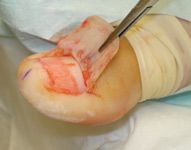- Case-Based Roundtable
- General Dermatology
- Eczema
- Chronic Hand Eczema
- Alopecia
- Aesthetics
- Vitiligo
- COVID-19
- Actinic Keratosis
- Precision Medicine and Biologics
- Rare Disease
- Wound Care
- Rosacea
- Psoriasis
- Psoriatic Arthritis
- Atopic Dermatitis
- Melasma
- NP and PA
- Skin Cancer
- Hidradenitis Suppurativa
- Drug Watch
- Pigmentary Disorders
- Acne
- Pediatric Dermatology
- Practice Management
- Prurigo Nodularis
- Buy-and-Bill
Article
Nail surgery: Creative alternatives provide full access to treatment area
Traditional teaching for nail surgery proposes complete nail removal, but there are a variety of options - not just for total nail avulsion techniques, including the lateral nail plate curl and the trap-door avulsion - but also for partial nail avulsion, according to Nathaniel Jellinek, M.D.

Key Points

"Complete nail plate avulsion is a nice way of exposing the entire nail apparatus, but sometimes the pathology we're going for is more localized, and we can decrease morbidity and get just as good exposure by using different avulsion techniques or partial avulsion," says Dr. Jellinek, assistant professor, department of dermatology, Brown Medical School.
"With such methods, we can replace the nail plate in anatomic position when we're finished, if we don't need to process it for pathology or microbiology," he says.
Lateral nail plate curl


The procedure would be appropriate for challenges such as accessing or exploring a pigmented lesion, tumor, or foreign body in the lateral or midline nail apparatus, Dr. Jellinek says.
'Trap-door' avulsion
Another variation on the complete plate avulsion is a technique called the "trap-door" avulsion, described by David de Berker, M.D., of the Bristol Royal Infirmary, Bristol, England.
The technique involves undermining only the ventral aspect of the plate, moving distal-to-proximal on the undersurface of the nail plate and then lifting the nail plate like a trap door to expose the underlying nail apparatus, with the exception of the proximal-most matrix, cul-de-sac and eponychium, Dr. Jellinek says.
"It's very similar to a total plate avulsion, but you don't undermine the dorsal aspect of the plate," he says.
"If you're looking at the nail bed or are performing distal matrix surgery, this is a nice technique, but if you're looking at proximal matrix surgery or are exploring the proximal matrix, it's probably less appropriate," Dr. Jellinek says.
Both techniques allow for the nail's return to its anatomic position.
"Returning the nail plate to anatomic position when finished with surgery is beneficial, because it serves as a biologic dressing, and there may even be some keratinocytes on the ventral surface of the plate that act as a split-thickness skin graft of sorts," Dr. Jellinek says.
The nail plate can also help protect the area postoperatively, which may help reduce pain and prevent infection by providing a postoperative barrier, he says.
Partial proximal nail plate avulsion
Some techniques for more limited nail plate avulsion include the partial proximal nail plate avulsion, which is useful in nail matrix surgery because it provides exposure to the entire matrix, from the cul-de-sac to the matrix bed junction, as well as the eponychium.





